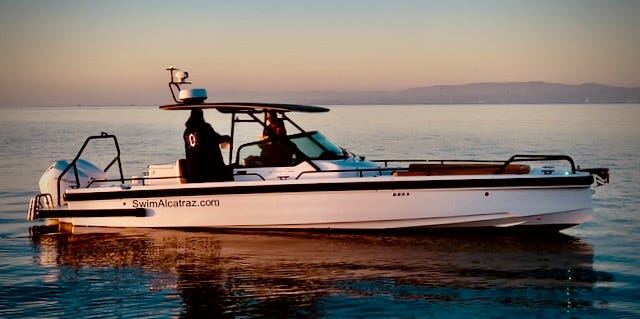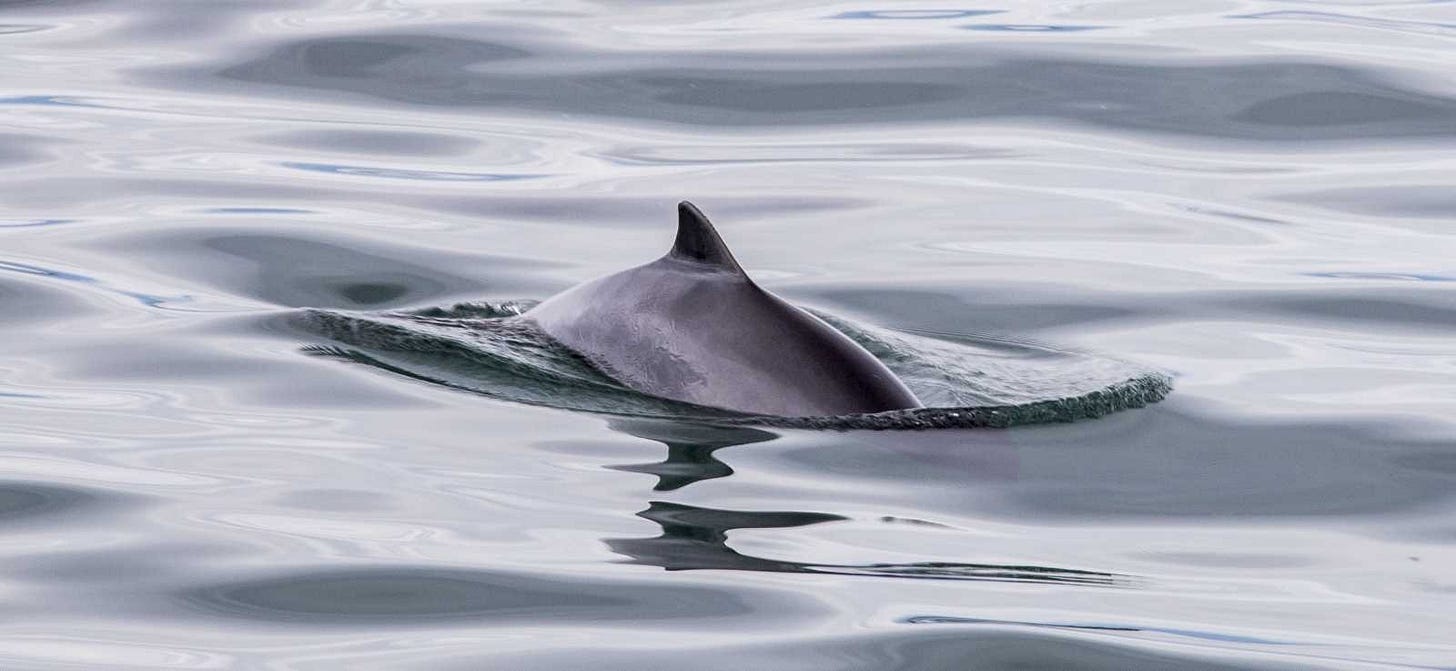Sharks in San Francisco Bay: Myths, Facts & Safety for Swimmers
Separating Myth from Reality: A Swimmer’s Guide to Sharks in San Francisco Bay
What You Need to Know in Three Lines
SF Bay’s sharks are small species—with no documented threat to swimmers on record.
White sharks rarely visit; no attacks on swimmers in 150+ years in the Bay.
Murky waters deter white sharks—history backs the Bay’s safety

Swimming in San Francisco Bay has thrilled folks for over 150 years—don’t let shark myths scare you off. We’ve swum the Bay and been members at South End Rowing Club (1873) and Dolphin Club (1877) for 22+ years in the last decade, have been logging 2,500+ hours yearly at Pacific Open Water Swim Co. and SwimAlcatraz.com, piloting swimmers from around the world. To our knowledge—and that of many longtime swimmers—there have been no confirmed white shark sightings inside San Francisco Bay during open water swims. No shark dorsal fins, no close calls—no nothing. Sharks swim here, but available records indicate no confirmed white shark attacks inside San Francisco Bay.

Sharks in the Bay: The Facts
Sharks inhabit San Francisco Bay, but the commonly found species are small and not known to pose a significant risk to swimmers. Leopard sharks, typically 2-3 feet long, feed on fish and crabs and are harmless to humans. Sevengill sharks, which are smaller inside the Bay than offshore, primarily scavenge along the bottom and rarely surface near swimmers. Thresher sharks prefer deeper waters outside the Bay, making encounters with people extremely rare. According to shark researcher Greg Skomal’s findings1 on shark habitat preferences, murky waters like those in the Bay further deter larger predators such as white sharks.

White sharks live along California’s coast but rarely enter San Francisco Bay. Shark researcher Greg Skomal notes2 that white sharks prefer clear waters near abundant seal populations for hunting—conditions found at hotspots like the Farallon Islands rather than inside the murky Bay. Sightings within the Bay are rare: notable examples include a 2015 seal predation near Alcatraz and a 2020 fisherman’s report. Longtime Bay swimmers—some in the water daily for over half a century—confirm no white shark sightings inside the Golden Gate Bridge and no recorded attacks.
Attacks? None Recorded Inside The Golden Gate
There are no confirmed records of white shark attacks on swimmers inside the Golden Gate Bridge. A fatal incident took place in 1959 at Baker Beach, outside the Golden Gate. Vague diver tales from 1851 discuss an attack or interaction near an Alameda fish cannery. However, what happened is unclear and this could have been a non-attack-related observation or interaction.
Understanding Shark Behavior
Greg Skomal’s research sheds light on why certain shark species thrive in San Francisco Bay while others avoid it entirely. Smaller species like leopard sharks favor shallow waters for feeding and breeding, while great white sharks prefer deeper areas with steep drop-offs near seal colonies for hunting. Murky waters like those found in the Bay further deter larger predators such as white sharks because visibility is critical for their hunting strategies.
Safety Tips Backed by Shark Research
While history shows no recorded white shark attacks inside San Francisco Bay, expert advice can still help swimmers minimize risks during open-water swims anywhere along California’s coast. Greg Skomal recommends3 swimming in groups rather than alone, avoiding dawn or dusk swims when shark activity is higher, steering clear of areas with seals or bait fish, and minimizing excessive splashing that could attract curiosity from marine life.
Separating Myth from Reality
The “Shark-infested” talk started with Alcatraz guards and grew through TV and movie hype—none of it holds up under scrutiny. Thousands swim in the Bay yearly without shark incidents; currents, cold water, and fatigue pose far greater risks than sharks. Wildlife such as porpoises, seals, and sea lions appear almost daily on our swims but typically keep their distance from humans. As Greg Skomal emphasizes in his research4 on public perception versus reality, fear of sharks often overshadows their ecological importance and rarity of interactions with humans.
Wildlife in the Bay: What You Might See
San Francisco Bay teems with marine life beyond sharks—here’s what swimmers might spot. Harbor porpoises swim in small groups; their recent comeback signals cleaner, healthier water. Bottlenose dolphins, though rare, zip by in pods now and then—quite a sight. Seals and sea lions hang out often but typically keep their distance from swimmers. We often see gray and humpback whales passing through the Bay in spring and fall, heading between Mexico and Alaska. While marine animals in the Bay rarely interact with swimmers, their behavior cannot be predicted with certainty.
Sea Lions: The Rare Close Call
Marine mammals usually steer clear, but sea lions have nipped swimmers at Aquatic Park a few times from 2019 to 2022. These incidents—uncommon and tied to possible territorial or health issues—caused minor injuries that healed fully. Most swimmers see seals and sea lions from afar or get a quick glance. If one nears: stay calm, swim steady, and signal your escort boat. Our USCG-licensed captains position vessels to reduce close encounters, often before swimmers notice.

Risk in Perspective
While open water swimming carries inherent risks, interactions with marine life are statistically uncommon in San Francisco Bay. History shows encounters are few and far between. Compare that to city biking, driving to the Bay, or a kitchen slip—shark odds beat lightning strikes any day.
How We Focus on Safety
Pacific Open Water Swim Co. puts safety first, no question. We check the weather, currents, and vessel traffic daily, adjusting our swims as needed. Swimmers get briefed on safety protocols, course tactics, wildlife, and how to handle the above. Our USCG-licensed captains and boats stay close to our pace-matched swimmers, always coordinating with authorities to keep things smooth. After 22 years of swimming here and 2,500+ hours on the water yearly, our operational experience is extensive, and we apply industry-standard precautions and training to promote swimmer safety. Ultimately, swimmers are responsible for assessing their personal fitness, awareness of conditions, and the risks involved in any open water swim.

The Bay Welcomes Swimmers
For 150+ years, people have swum the Bay with confidence. Risks exist, but marine life trouble is rare. Swim smart, stay aware—join a community that’s thrived here forever. Check out SwimAlcatraz.com or SwimSF.com for your shot at the Bay’s best.

Disclaimer: This article is for general informational purposes only and does not constitute safety advice, scientific authority, or legal assurance. While care has been taken to present accurate information from credible sources, conditions in San Francisco Bay can vary. Swimmers must use their judgment and consult professionals for site-specific risks.
Pacific Open Water Swim Co. also operates SwimAlcatraz.com, specializing in Alcatraz swims and offering one of the most extensive sets of opportunities to experience San Francisco’s iconic open water swims.
Skomal, G. (2025). Chasing Shadows. Insights into shark behavior and habitat preferences. Blue Dot Living.
Frontiers in Marine Science (2021). “Three-Dimensional Movements and Habitat Selection of Young Sharks.” Frontiers.
Atlantic White Shark Conservancy (2021). “New Research Sheds Light on the Habits of White Sharks off Cape Cod.” Atlantic White Shark Conservancy.
Skomal, G. (2025). Chasing Shadows. Insights into shark behavior and habitat preferences. Blue Dot Living.
Save Our Seas Foundation (2024). “Seasonal Predation of White Sharks on Seals.” Save Our Seas.
Wikipedia (2025). “List of Sharks in California.” Wikipedia.
Shark Stewards. “Great White Sharks in the San Francisco Bay.” Shark Stewards.
ABC13 Houston. “How to Protect Yourself from Sharks at the Beach.” ABC13.
Save Our Seas Foundation. “Greg Skomal - Seasonal Predation and Environmental Conditions.” Save Our Seas.
Shark Stewards (2025). “Great White Sharks in San Francisco Bay.” Shark Stewards.
Frontiers in Marine Science (2022). “Shark Incidents in California 1950-2021: Frequency and Trends.” Frontiers.
Save Our Seas Foundation (2024). “Gregory Skomal - Seasonal Predation and Environmental Conditions.” Save Our Seas.





